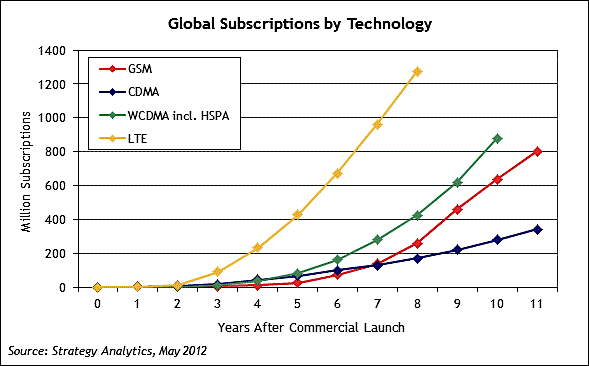
Unsurprisingly, 4G LTE is the fastest growing cellular network technology, in part for what it delivers and deployment's timing. Strategy Analytics forecasts that 4G LTE will reach 1 billion connections, or 15 percent of all, by 2017. That compares to 12 years for GSM and about 11 years for WCDMA to reach as many.
But LTE isn't gain without pain. In the United States, Verizon by far and large has the most expansive 4G network, reaching 250 metro areas and 200 million Americans compared to 38 metros and 75 million people for AT&T. Adoption still is fairly low, perhaps because phone subscribers don't understand the value. Meanwhile, Verizon will axe grandfathered unlimited plans when subscribers upgrade to LTE. There's pain for the gain.
Attitudes are changing, particularly among carriers. "It has taken some time to warm up, but operator sentiment toward LTE has improved significantly over the last year," Phil Kendall, Strategy Analytics director, says. "The LTE smartphone market is providing this sudden lift, with LTE’s medium-term potential boosted by the much greater scale in today’s mobile market: WCDMA launched into a world of fewer than one billion mobile connections, whereas we have over six billion connections today".
Here in the States, more carriers offer LTE smartphones -- the majority Androids, a few Windows Phones and none iPhones. AT&T started with the HTC Vivid and Samsung Galaxy S II Skyrocket in November. Since, the carrier added nearly a half-dozen more. Verizon offers about 12 LTE smartphones, while, Sprint, which is in early-stage network deployment offers two, while US Customs bars a third, the HTC EVO 4G LTE, because of a patent dispute with Apple.
"The race is on for mobile operators to reduce cost per Gigabyte (GB) to match the rate at which revenue per GB is falling, Sue Rudd, Strategy Analytics director, says. "LTE is one of the key tools to deliver this improvement, with the early volume in LTE devices an encouraging sign for operators looking to maximize return on their LTE investments".
While carriers invest in LTE, one of the most popular smartphones doesn't support the technology. Apple fakes out iPhone users, after updating iOS to version 5.1 and changing the 3G to 4G, which satisfies AT&T marketing but not what is 4G. Fake 4G marketing -- from Apple, AT&T, T-Mobile and others leads consumers to believe they have something they do not, which dulls LTE benefits.
That's good for existing HSPA+ handsets, iPhone among them, but fosters confusion, as this Saturday Night Live parody so aptly illustrates.

